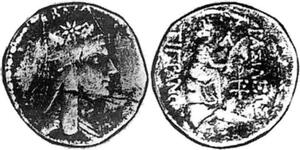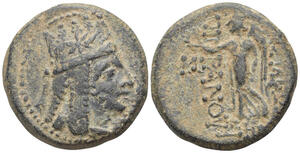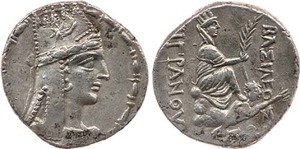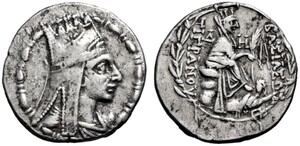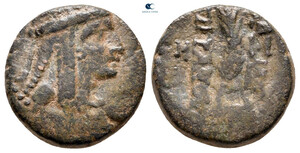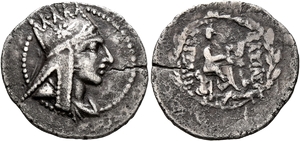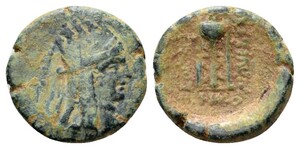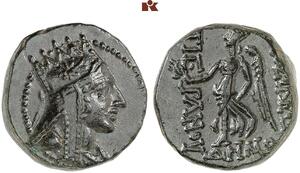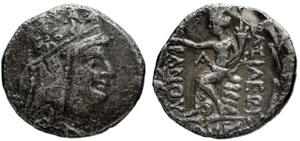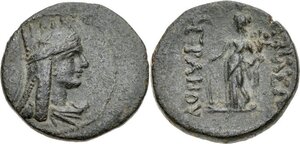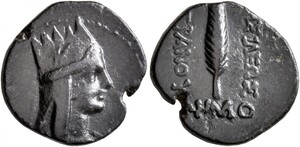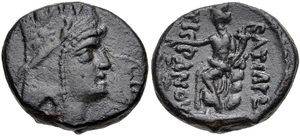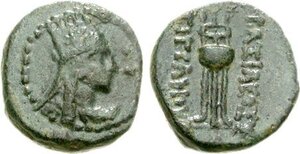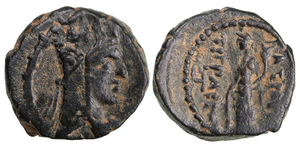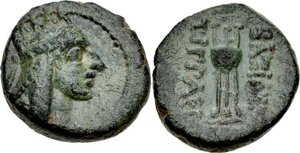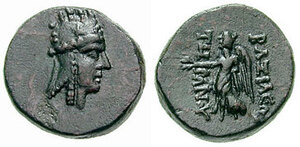Tigranes the Younger 77/6-66 BC
Description
Tigranes the Younger (BNP [31]) was born around 100 BC while his father Tigranes II was still a royal hostage at the Parthian court of Mithradates II. During his father's reign the younger Tigranes distinguished himself as a field commander and was elevated to co-regent in the latter's twentieth year, 77/6 BC.
Numismatic evidence suggests Tigranes the Younger was in Damascus from 71/70 until 69/8. It may be during this separation from his father that he began negotiating an alliance with his father-in-law, Phraates III (70-57 BC), the purpose of which was to overthrow the elder Tigranes (Shayegan 2011, 326).
Armenia's alliance with Mithradates of Pontus at this point was causing problems with Rome in the context of the Mithradatic War, resulting in father and son uniting against the threat of Roman invasion. When Tigranes fled the advancing Roman legions leaving his son in charge Tigranes the Younger betrayed his father to Pompey, hoping to emerge as sole ruler of all Armenia. Tigranes II, now out of options, surrendered in person to Pompey and submitted unconditionally.
Pompey's reorganization was a great disappointment to Tigranes the Younger, as Pompey, who was suspicious of his Parthian connections, gave him little more than Sophene.The elder Tigranes fared better: Pompey gave him Armenia Major and a few other provinces. Pompey levied a heavy indemnity on both father and son, which the latter was unwilling or unable to pay. In 66 BC, after only a few months, Pompey removed Tigranes the Younger from Sophene and gave the kingdom to Ariobarzanes I of Cappadocia.
Although there is literary evidence for the co-regency of Tigranes the Younger, as well as for his brief usurpation and subsequent reign as king of Sophene, the two most widely used references on Armenian coins do not even mention his name. Mousheghian and Depeyrot (HRAC 44,4) discuss the possibility of a coinage for the Younger, citing Foss (1986a, 64-66; 1986b, 19-66), but conclude that there is "not any evidence that Tigranes the Younger has ever struck any coin."
In fact, there is sufficient numismatic evidence when the coins of the reign of Tigranes the Great are sorted and arranged as proposed here. The coins of Tigranes the Younger are distinguished from those of his father by their younger portraits and by the comet decoration on the tiara. The comet may be a birth sign referring to the comet of 100 BC (Ramsey 2006, 91), to a comet of 76 BC (Ramsey 2006, 101) coinciding with his coronation, or to both occurrences. His title throughout is "King Tigranes," never "King of Kings," suggesting that his father counted him as a subordinate king rather than an equal.
The first coins issued for Tigranes the Younger may have been on the occasion of his investiture. Perhaps Kov-128-131 from Tigranocerta and the bronze Kov-158 from Artaxata(?) should be considered in this context, though there is no way at present to be certain. His remaining coins generally correspond to Series 4-6 of Tigranes II as will be noted in the catalogue listings; the exception is the Damascus coinage of 71/70-69/8 BC, for which there is no related issue of Tigranes II.
There is one noteworthy deviation in the iconography of the Damascus coins. The normal comet decoration on the crown has become two separate elements: a star and a bull's horn. Whether this new design has some other symbolic value or is simply a misunderstanding of the normal comet design is, for now, an open question.
The last coinage of this reign, Series 7 (66/5 BC), is of very different style than the previous, and does not have a counterpart in the coinage of TigranesII. Perhaps Series 7 belongs to the Younger's reign in Sophene. The tetradrachms and drachms represent the only substantial silver issue for Tigranes the Younger's ten year reign, suggesting that they may have been produced to pay (if only in part) the indemnity required by Pompey. There is only one obverse die for the tetradrachms paired with four reverse dies and one obverse die for the drachms (with one reverse die) which may be interpreted as evidence of a very short-lived production (SCADA pl. 78-79). The drachm obverse die is also used for tetrachalkoi (Kov-155). The mint for this last issue could be Tigranocerta, but Artagigarta, the capital of Sophene, must also be considered.
Kovacs, Frank L. “Armenian Coinage in the Classical Period” CNS 10, Classical Numismatic Group, Lancaster, 2016, pp. 21-22.
Numismatic evidence suggests Tigranes the Younger was in Damascus from 71/70 until 69/8. It may be during this separation from his father that he began negotiating an alliance with his father-in-law, Phraates III (70-57 BC), the purpose of which was to overthrow the elder Tigranes (Shayegan 2011, 326).
Armenia's alliance with Mithradates of Pontus at this point was causing problems with Rome in the context of the Mithradatic War, resulting in father and son uniting against the threat of Roman invasion. When Tigranes fled the advancing Roman legions leaving his son in charge Tigranes the Younger betrayed his father to Pompey, hoping to emerge as sole ruler of all Armenia. Tigranes II, now out of options, surrendered in person to Pompey and submitted unconditionally.
Pompey's reorganization was a great disappointment to Tigranes the Younger, as Pompey, who was suspicious of his Parthian connections, gave him little more than Sophene.The elder Tigranes fared better: Pompey gave him Armenia Major and a few other provinces. Pompey levied a heavy indemnity on both father and son, which the latter was unwilling or unable to pay. In 66 BC, after only a few months, Pompey removed Tigranes the Younger from Sophene and gave the kingdom to Ariobarzanes I of Cappadocia.
Although there is literary evidence for the co-regency of Tigranes the Younger, as well as for his brief usurpation and subsequent reign as king of Sophene, the two most widely used references on Armenian coins do not even mention his name. Mousheghian and Depeyrot (HRAC 44,4) discuss the possibility of a coinage for the Younger, citing Foss (1986a, 64-66; 1986b, 19-66), but conclude that there is "not any evidence that Tigranes the Younger has ever struck any coin."
In fact, there is sufficient numismatic evidence when the coins of the reign of Tigranes the Great are sorted and arranged as proposed here. The coins of Tigranes the Younger are distinguished from those of his father by their younger portraits and by the comet decoration on the tiara. The comet may be a birth sign referring to the comet of 100 BC (Ramsey 2006, 91), to a comet of 76 BC (Ramsey 2006, 101) coinciding with his coronation, or to both occurrences. His title throughout is "King Tigranes," never "King of Kings," suggesting that his father counted him as a subordinate king rather than an equal.
The first coins issued for Tigranes the Younger may have been on the occasion of his investiture. Perhaps Kov-128-131 from Tigranocerta and the bronze Kov-158 from Artaxata(?) should be considered in this context, though there is no way at present to be certain. His remaining coins generally correspond to Series 4-6 of Tigranes II as will be noted in the catalogue listings; the exception is the Damascus coinage of 71/70-69/8 BC, for which there is no related issue of Tigranes II.
There is one noteworthy deviation in the iconography of the Damascus coins. The normal comet decoration on the crown has become two separate elements: a star and a bull's horn. Whether this new design has some other symbolic value or is simply a misunderstanding of the normal comet design is, for now, an open question.
The last coinage of this reign, Series 7 (66/5 BC), is of very different style than the previous, and does not have a counterpart in the coinage of TigranesII. Perhaps Series 7 belongs to the Younger's reign in Sophene. The tetradrachms and drachms represent the only substantial silver issue for Tigranes the Younger's ten year reign, suggesting that they may have been produced to pay (if only in part) the indemnity required by Pompey. There is only one obverse die for the tetradrachms paired with four reverse dies and one obverse die for the drachms (with one reverse die) which may be interpreted as evidence of a very short-lived production (SCADA pl. 78-79). The drachm obverse die is also used for tetrachalkoi (Kov-155). The mint for this last issue could be Tigranocerta, but Artagigarta, the capital of Sophene, must also be considered.
Kovacs, Frank L. “Armenian Coinage in the Classical Period” CNS 10, Classical Numismatic Group, Lancaster, 2016, pp. 21-22.
Collection Tree
- ANCIENT
- Armenia Major
- Tigranes the Younger 77/6-66 BC
- Series 1 Tigranocerta; controls M or none (Kov 128-131)
- Series 2 Tigranocerta; controls ΣΩ (Kov 132-133)
- Series 3 Damascus; controls A, [HA], ΘΕΟΦ, [NP] (Kov 134-140)
- Series 4 Tigranocerta; controls [HA], [MO], ΔHMO (Kov 141-144)
- Series 5 Tigranocerta; controls ΔHMO (Kov 145-149)
- Series 6 Reigning alone; controls [PT] and A, [PT] and H (Kov 150-151)
- Series 7 Tigranocerta or Artagigarta; controls ΔH, ΔHMO, Π (Kov 152-157)
- Uncertain Mint. Artaxata(?) (Kov 158)
- Tigranes the Younger 77/6-66 BC
- Armenia Major


